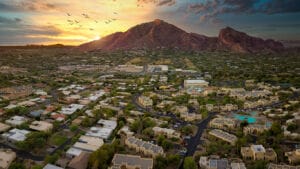Inside OutOpen air malls continue to gain in popularityBy Melissa Bordow
On an unseasonably cool night in late May, shoppers meander the streetscapes of Scottsdale’s Kierland Commons, strolling among its upscale stores and restaurant patios. When it opened as part of a mixed-use development in 2000, Kierland heralded a new wave in outdoor shopping — the lifestyle center, also known as the urban village. Sidewalks, curbside access to stores, landscaping and sit-down dining all combined to create an urban vibe, right smack in the middle of the suburbs, in this case, of North Scottsdale. This scene — people shopping, dining, and relaxing al fresco — now is being played out across the Valley, from Tempe Marketplace at the confluence of the 101 and 202 freeways south to the new San Tan Village in Gilbert. Open-air shopping, developers and analysts say, will continue to dominate the Valley’s retail landscape, shaping the way consumers shop, eat and spend their entertainment dollars. “Everybody is wrestling with the exact formula,” says Robert Mayhew, vice president of commercial properties at DMB Associates Inc. “There’s Desert Ridge (Marketplace), the first of its kind with the big box power center and a lifestyle center. There’s Chandler Fashion Center, which is indoors but has an outdoor component. What is the right mix?” In the past two years, developers have opened five high profile, open-air entertainment and dining retail centers: Vestar Development’s Tempe Marketplace, Westcor’s San Tan Village and the Promenade at Casa Grande, DeRito Partners’ Mesa Riverview, and The Ellman Companies’ The Village at Westgate City Center. Westcor, a dominant force in Valley retail, is planning open-air environments for its next five developments, although that could change for those not already under construction if market conditions dictate, says Garrett Newland, vice president of development at Westcor. Although it still embraces the enclosed-mall concept, Newland says Westcor has no plans on the drawing board for one. Westcor opened its last enclosed mall, Chandler Fashion Center, in 2001. Meanwhile, conventional mall anchors such as Dillard’s, J.C. Penney and Macy’s are continuing to open in outdoor mall environments, typically in Westcor properties. Some call it the “de-malling of America,” Mayhew says, adding, “Very few enclosed malls are being built any longer. Their days are almost gone.” Ten years ago, enclosed regional malls represented about 15.5 million square feet of retail space in metro Phoenix, while outdoor power centers and lifestyle centers comprised about 15.1 million square feet, according to figures from Kammrath & Associates, a retail consulting firm in Phoenix. Since then, outdoor shopping mall space has more than doubled to 35.1 million square feet, while indoor space has remained relatively stagnant. According to Kammrath & Associates, the trend started years ago with the advent of the power center, with its convenient vehicular access. Since then, the trend has only gained steam. What is driving shoppers outdoors? Quite simply, many shoppers prefer the natural setting of an outdoor environment over the “sterility” of enclosed malls, says David Larcher, executive vice president of development for Vestar, which opened Desert Ridge Marketplace in 2001 and Tempe Marketplace last June. “People are organic beings,” Larcher says. “They like, even in extreme climates like Arizona and Minnesota, to be outside. They like to see the flowers and smell the flowers, they like to feel the wind blow in their hair.” Desert Ridge’s and Tempe Marketplace’s comfortable, often cozy gathering areas and their attention to detail create destination spots even for those with no plans to shop. For suburbanites who lack proximity to anything resembling a downtown or city center, this can be very appealing. “A lot of indoor malls turned their back to the surrounding environment,” says Joe Murray, director of retail design for DAVIS. “Lifestyle centers gesture toward their environment and convey a sense of space and place.” Outdoor configurations allow developers more flexibility to change a site or try something innovative, says Westcor’s Newland. It is easier and cheaper to add a building to an outdoor grid. Building exteriors offer more diversity of architectural features, Mayhew says, which in turn provides more opportunity for branding or creating a singular identity. Retailers like them because they pay 35 to 60 percent less to maintain common areas, Larcher says. These central area maintenance (CAM) costs climb when retailers pay to air condition mall interiors. But it’s the air conditioning that many shoppers may miss during the Valley’s scorching summer months. While sales at Westgate showed a slight decline in the summer, it was not a significant drop, says Tim Wright, Ellman’s senior vice president of real estate operations. Providing shoppers adequate protection with shade structures, wide awnings and landscaping seems to help them endure the heat. In addition, interactive water features, fountains and misting systems cool both the environment and shoppers. “We can control the environment well enough in the summer to where it is comfortable to shop,” says Larcher, whose marketplace buildings are set apart to create maximum shade. He also notes that shopping revenues are seasonal and have their peaks and valleys anyway.
Extensive market research shows that Valley shoppers still want that sense of community and pedestrian-friendly experience they find in outdoor settings, says Ken Himmel, president and CEO of Related Urban Development, which is developing CityNorth along with the Thomas J. Klutznick Company. CityNorth is a mixed-use project in the northeast Valley. Himmel says “green space” with parks, courtyards and water features, along with covered parking, reduces the “heat island” effect produced in urban centers with vast parking lots and asphalt. www.westcor.com
|
Home / Real Estate / Open Air Malls Continue To Gain in Popularity





